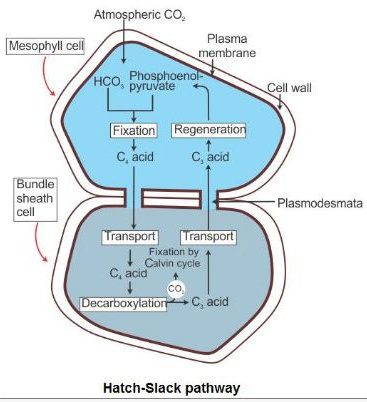explain c4 pathway
Hatch–Slack Cycle or C4 Cycle
-
The C4cycle is found in tropical and subtropical grasses such as maize, sugarcane, pear, millet, all the other monocots and dicots such asAmaranthusand Euphorbia.
-
C4plants are adapted to overcome photorespiration and deliver CO2directly to theenzyme RuBisCO.
-
Initial Fixation
i. Carbon dioxide is first fixed in the mesophyll cells to form a 3C compound—phosphoenol pyruvic acid (PEP), leading to the formation of a 4C compound, oxaloacetic acid (OAA) which is transaminated to form malic acid or aspartic acid.
ii. Aspartic acid is then transported to bundle sheath cells through plasmodesmata -
Final Fixation
i. Inside the bundle sheath cells, malic acid is decarboxylated into pyruvic acid and aspartic acid is deaminated into alanine.
ii. CO2released in bundle sheath cells is fixed through the Calvin cycle in which RUBP is the secondary or final acceptor of CO2in C4plants -
Regeneration of PEP
i. Pyruvic acid or alanine formed in the bundle sheath cells return to the mesophyll cells.
ii. Alanine is deaminated through a transamination reaction to form pyruvic acid.
iii. Pyruvic acid is converted to phosphoenol pyruvic acid and inorganic phosphate with the help of ATP
C4 plants require a total of30 ATP and 12 NADPH molecules to synthesise one molecule of glucose from6 molecules of CO2
